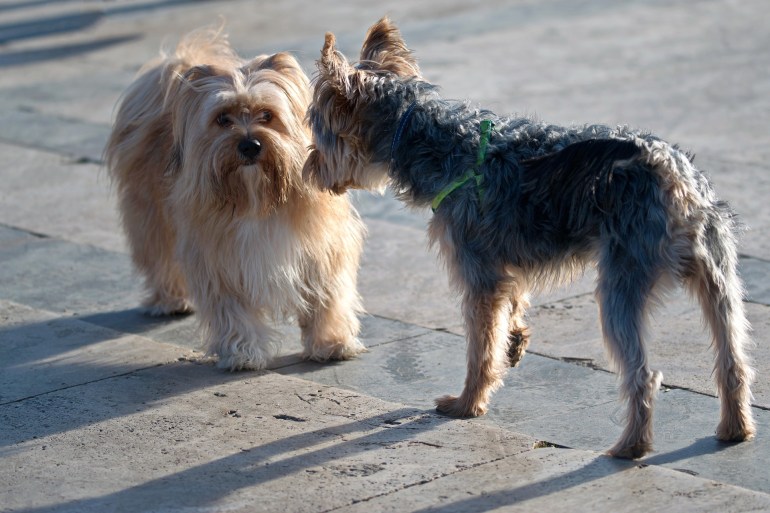While the Fédération Cynologique Internationale recognizes 340 dog breeds, there are only 42 cat breeds recognized in the United States, according to the Cat Fanciers' Association.
Also, in addition to the vast difference between the number of dog and cat breeds, it is also noticeable that the differences in size and shape between cat breeds are very faint and weak, compared to the amazing physical differences between dog breeds.
Cats and Dogs Jobs
Why do cats not show the same extremes in body size and shape as we observe in dog breeds?
Mendy Weissberg poses this question on Livescience, and answers that perhaps the answer lies in the jobs each of them does.
Domestic cats have been exploited in almost one function by humans, which is pest control and catching mice, a function appropriate to the shape and size of the bodies of small cats, so their sizes have not been tampered with, so they have the same appearance, despite the fact that the breed of wild cats differs in size and appearance from Domestic cats.
As for domestic dogs, they have been bred for a number of different jobs and tasks, such as hunting, guarding, grazing and pulling carts, in addition to the fact that they hunt and guard different types of animals.
Therefore, there are different types and forms of dogs, such as hunting dogs, fields, shepherds, guard, police, escort of the blind and toboggans, which are used to pull carts on the ice to our time.
Most of the selection processes that have produced the cat breeds recognized today have been made over the past 75 years (Pixabay)
Selective breeding
People differed in different countries about the best types or capabilities of dogs that do each task separately, so this was a great diversity in working dog breeds, as breeders choose the types of dogs that they use precisely, until it came to breeding certain dogs for appearance and fashion.
Domesticated dogs have been monitored and manipulated over time through selective breeding to produce animals with certain traits continuously, Leslie Lyons, a professor at the University of Missouri's College of Veterinary Medicine, told Live Science.
She adds that unexpected differences in the appearance of a raised animal, such as unusual size, for example, lack of a tail, curly hair or strange markings;
It is the result of genetic mutations that appear naturally all the time, and then these signs persist across generations thanks to people who find the new trait attractive, and maintain its presence through reproduction.
Mutations do happen, but humans choose what they prefer.
According to Ellen Ostrander - a senior researcher in genetics and comparative genomics at the National Institute for Human Genome Research, at the US National Institutes of Health - most of the selection processes that have produced the cat breeds recognized today have taken place over the past 75 years, while dog breeds have formed several hundred years ago. The years.
Domesticated dog species have been monitored and manipulated through selective breeding (pixabay)
Old coworkers
Both cats and dogs lived side by side with people long before the various subspecies of each emerged.
Structural evidence from western Russia and excavated remains indicate that the domestication of dogs, i.e. the adaptation of wild animals for human use, dates back at least 19,000 years, while cats were domesticated only about 10,000 years ago.
According to Ostrander, as the human-dog partnership developed, people soon realized that dogs could perform their highly specialized tasks.
Through selective breeding, people living in different environments began to form dogs that could help humans survive.
The two goats in mountainous regions, for example, call for different features in the dog than herding sheep in pastoral lands, and some people have raised dogs to guard the property, or help in lifting heavy loads on a farm, or hunt certain types of animals, such as deer The big and powerful, or the small and fast mice.
"Our data shows that deliberate crossbreeding and selecting specific traits played a major role in the amazing diversity we see in dog breeds today," says Ostrander.
In comparison, cats usually played one of two roles in human families, which is companionship or pest control, and cats performed these fairly simple tasks quite well and in proportion to their shape and size, so their owners were not inclined to significantly reshape the cats’s bodies.
Deliberate crossbreeding and selection of certain traits played a major role in the diversity of dog breeds (pixabay)
The danger of selective breeding
Ostrander cautions about the drawbacks of selective breeding, as strong selection often results in reduced overall diversity.
In some cases, mutations associated with ancestry traits come with a genetic cost associated with them, as some exaggerated physical traits can cause health problems, especially in dog breeds.
Lyons says that scientists' findings are being tracked about the genetics of cat and dog breeds, to prevent the bad things that come with the goodies that breeders want from happening.

